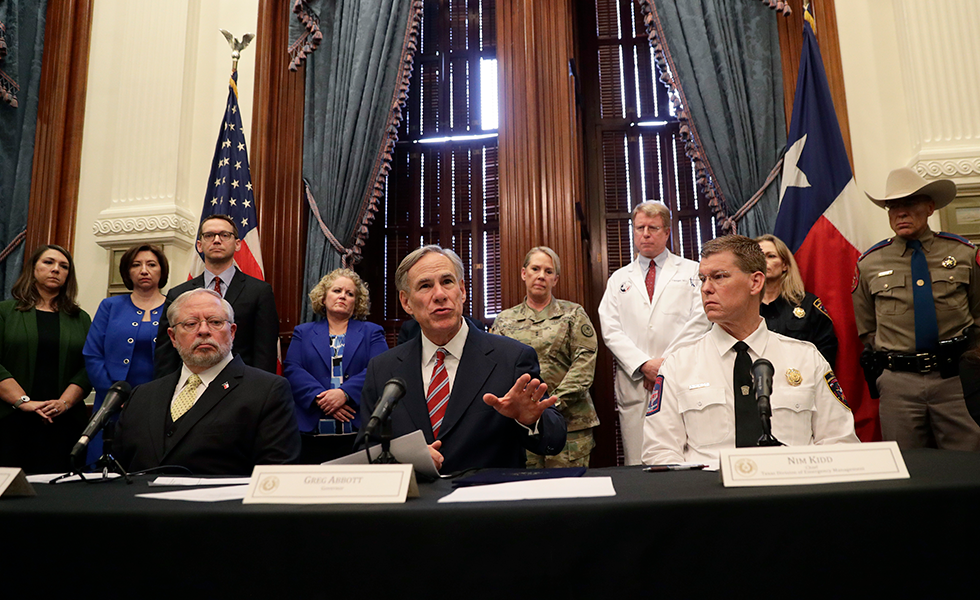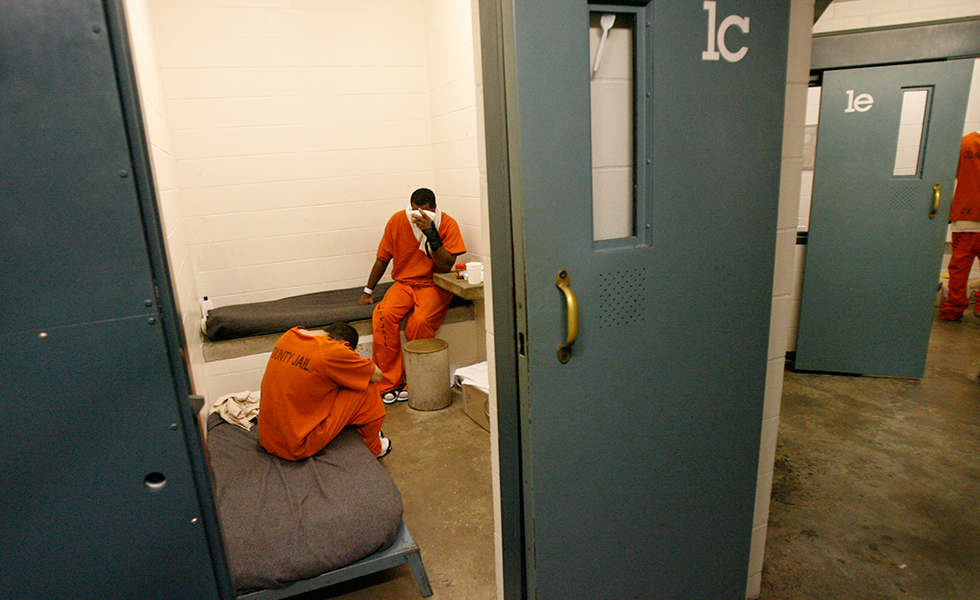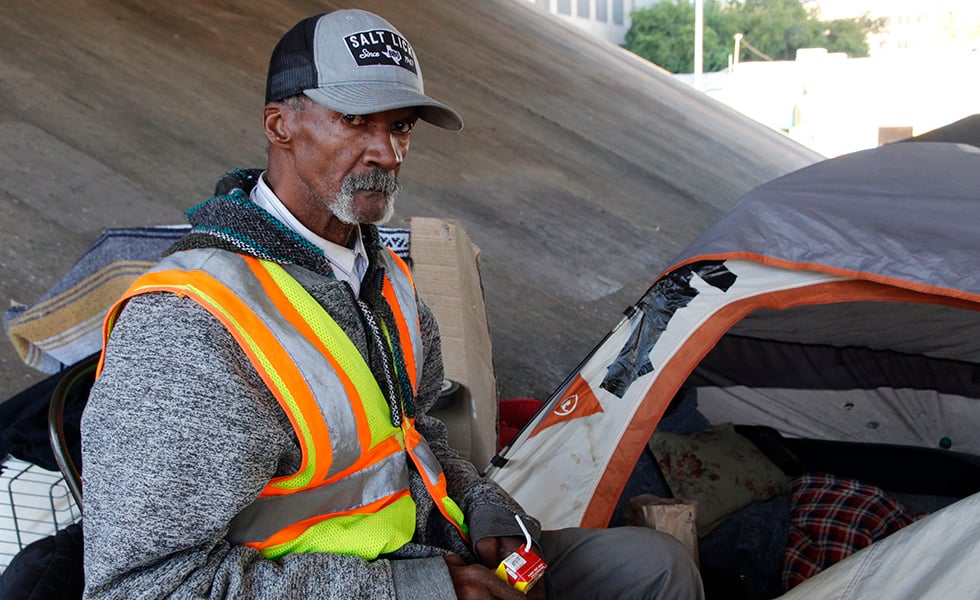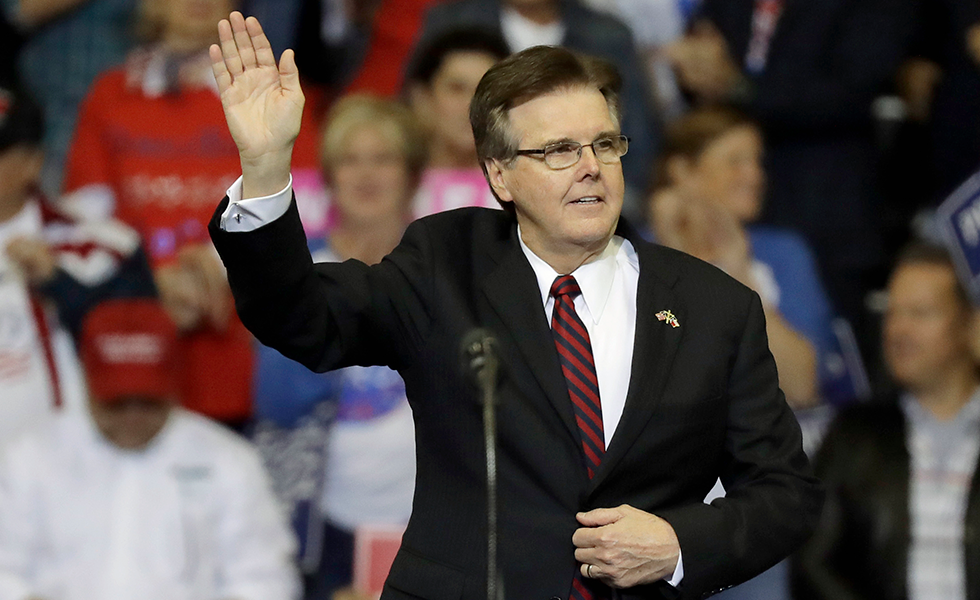
A ‘Stay-at-Home’ Order by Any Other Name
At a time when clear and decisive action is paramount, Governor Greg Abbott has delayed, deferred, and equivocated, likely costing lives.

Above: Texas Governor Greg Abbott, center, gives an update on the coronavirus on Friday, March 13, 2020, in Austin.
Twenty-six days after an elderly Fort Bend man became the first presumptive positive case of COVID-19 in Texas, Governor Greg Abbott convened a press conference at the Capitol. It was the last day of March, and Texas’ official case count had reached 3,266 with 41 fatalities.
Those numbers were expected to increase dramatically in the coming weeks. Public health and medical officials were hopeful that the governor would finally issue a statewide stay-at-home order, which Texas’ biggest counties had already implemented.
But by the end of the press conference, it wasn’t at all clear what the governor had done. Reporters and local officials came away scratching their heads.
Abbott had announced a new executive order establishing what he dubbed “essential services and activities protocols,” but went out of his way to make clear that it was not a “stay-at-home strategy.” While the order effectively brought all of Texas in line with other state orders, Abbott’s message was so muddled that he was forced to release a video the following day clarifying that his order “requires all Texans to stay at home” except for essential services.
Abbott’s initial resistance to label his action a “stay-at-home” order—which had become anathema to many on the right—is emblematic of his response to the coronavirus outbreak as a whole. Until his executive order, he had been happy to leave it up to local county and city officials to make the tough political decisions to close down businesses and public activity. His insistence that mayors and county judges should be empowered to respond as they see fit was astoundingly hypocritical. The notorious anti-local control zealot had spent the months preceding the outbreak lashing out at Austin city leaders and the homeless over a new camping ordinance, eventually launching a quasi-state intervention.
Abbott’s defense for inaction was that the state is large, and he didn’t want to impose restrictions on areas with no confirmed cases. “I am governor of 254 counties in the state of Texas,” he said. “What may be right for places like the large urban areas may not be right at this time for more than two hundred counties that have zero cases of COVID-19.” Testing, however, has been disturbingly limited in the state, likely making the daily confirmed case count a sliver of the wider picture. And as public health experts warned, the time to shut down is before there are confirmed cases.
Meanwhile, Abbott’s tepid leadership allowed other Texas officials to fill the void by flouting the recommendations of public health experts. Lieutenant Governor Dan Patrick went on Fox News and issued a call for the elderly to sacrifice themselves for the sake of the economy—a sentiment that was then gaining ground with many in the GOP, including the president. And last week, Chris Hill, the county judge in suburban Collin County, which borders Dallas County—where the first local stay-at-home-order was enacted—declared every business to be “essential.”
Meanwhile, Abbott has been more than happy to insert a healthy dose of red meat into the state response. When he issued an executive order putting a temporary halt on all non-essential medical procedures, Abbott signaled that this included abortions, prompting Attorney General Ken Paxton to announce that there was now a statewide ban on the procedure when the mother’s life isn’t in danger. And as officials in Harris County began preparing to release hundreds of jailed inmates—many of whom hadn’t had a trial—on bail in an effort to prevent a deadly outbreak, Abbott issued an executive order prohibiting inmates accused or previously convicted of violent crimes from being released without paying bail, claiming that “releasing dangerous criminals makes the state even less safe … and slows our ability to respond” to the COVID-19 outbreak. (Harris County judges said they plan to ignore the order and defense attorneys have asked a federal judge to temporarily block the order.
Abbott has also emphasized that, in a time of global pandemic, God and guns are essential. With his support, Paxton issued a legal order ruling that gun stores were to be considered essential services. And after evangelical extremist Steve Hotze sued Harris County for its order requiring that religious services be held remotely, Abbott included religious services as “essential,” prompting concerns that reckless pastors might try to hold large, in-person services. Abbott was, again, forced to later clarify that religious institutions “must” hold services remotely “whenever possible.” At a time when clear and decisive action was paramount, the governor delayed, deferred, and equivocated, likely costing lives.
But give the governor a little credit. While President Donald Trump has whipsawed from conspiratorial denialism to active misinformation and back again, Abbott has at least resisted the sort of gubernatorial conspiracizing and fear mongering theatrics he’s indulged in the past. Of course, there’s still time.
Find all of our coronavirus coverage here.
Read more from the Observer:
-
Migrants and Advocates Call to Close Detention Centers as COVID-19 Spreads: A new lawsuit argues that an outbreak in detention could overwhelm local health care systems.
-
As Texans are Exposed to Dangerous Pesticides, Lawmakers Aren’t Doing Anything: Pesticide drift is exposing rural Texans to dangerous chemicals. But lawmakers are more concerned with how that is eating into Big Ag’s balance sheet.
-
The Future of Fair Housing in Texas: John Henneberger has spent 45 years advocating for Texans’ right to have a safe, affordable place to live.


